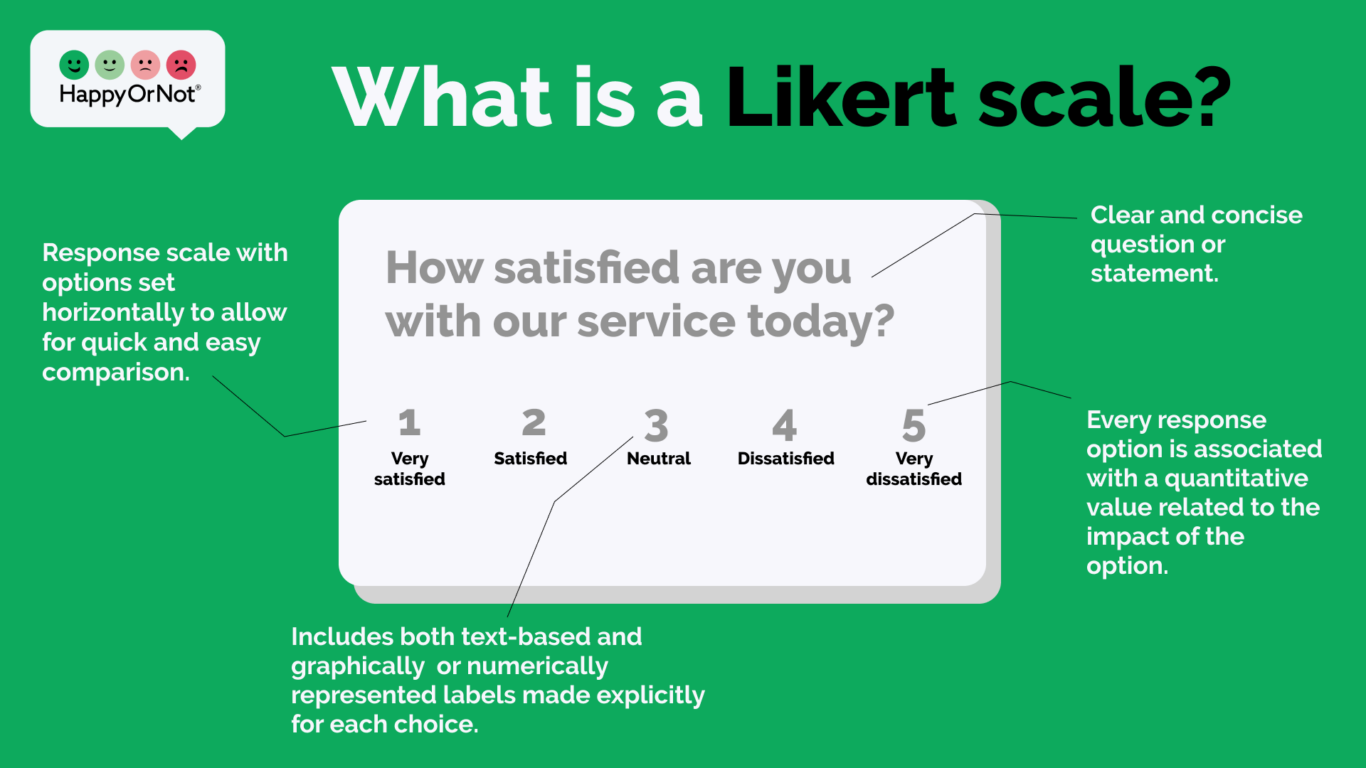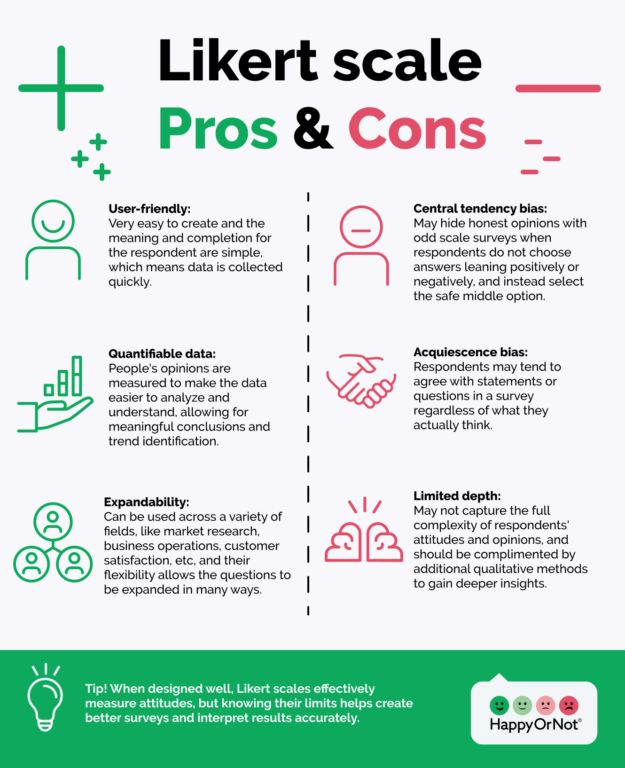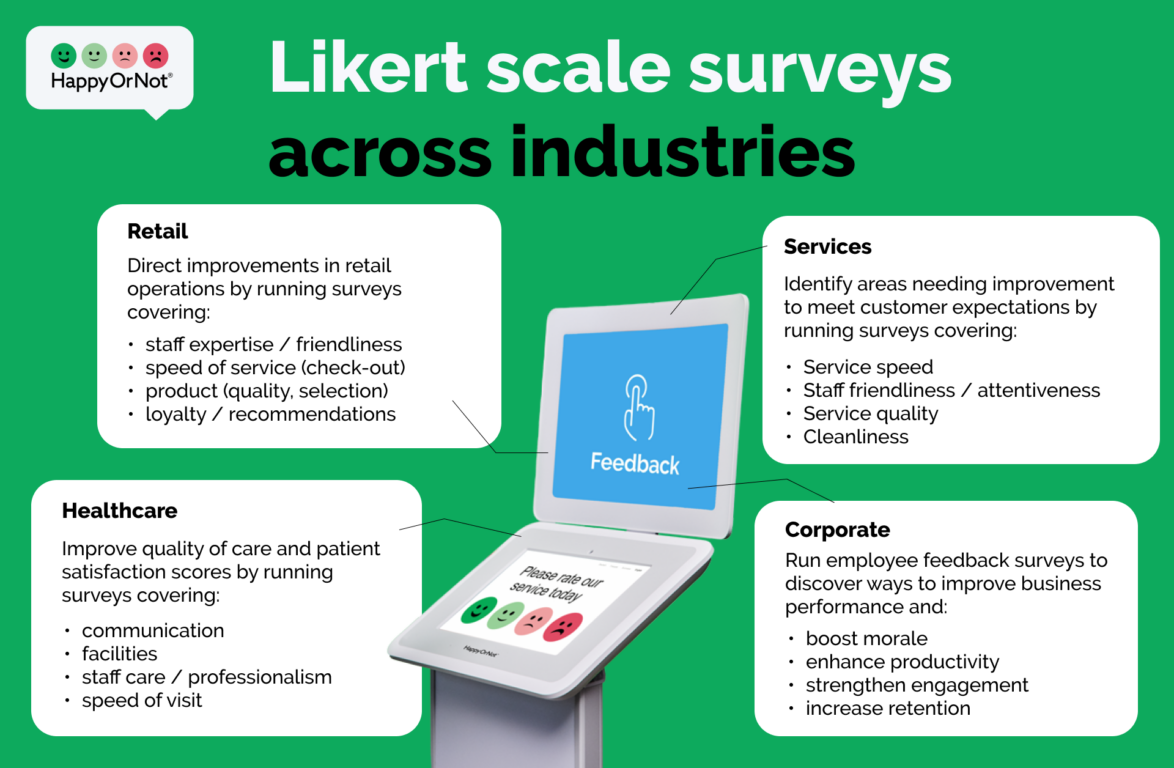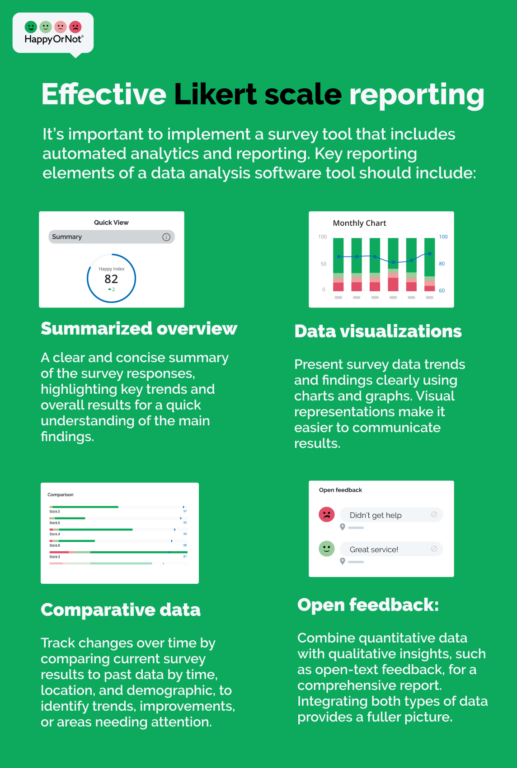Likert scales: The ultimate guide to understanding and creating them
Anyone dealing with survey research, customer feedback, or employee engagement must understand Likert scales. The Likert scale is applied to quantify attitude, opinion, and behavior. In this in-depth look, we’ll explore the history of Likert scales, how they’re built, and the applications, especially about the 5-point Likert scale.
Real-life examples of Likert scales will be shown for illustrative purposes, along with how you can construct a well-designed Likert scale in the design of your surveys. The main aim is to provide you with adequate knowledge so that you may design and interpret Likert scales correctly and improve quality results from your research.
History and development of the Likert scale
The Likert scale was first developed in 1932 by a psychologist named Rensis Likert at Columbia University while he was working on his thesis. Likert was measuring subjective psychological attitudes “scientifically.” He invented a technique whereby numerical values are attached to the answers to quantify attitudes and opinions.
Ever since, it became one of the approaches within the realm of survey research, widely adopted as a cornerstone of simple and practical approaches. Whereas Likert was building on past ways of measuring attitudes, he came out to be the first to advocate for a standardized method to be duplicated and analyzed easily, thus leading to the technique used in surveys among people today.
What is a Likert scale?
A Likert scale is a psychometric scale in questionnaires designed to measure how respondents feel toward different options ─ the attitudes or opinions of an individual, either as responses to a set of statements or a single question. The basic definition is this: a simple rating scale with some statements, with respondents indicating the extent they agree or disagree with each statement or question. Precisely put, the 5-point Likert scale enables responses to vary from:
- Strongly agree/Very satisfied: This signifies a high level of agreement with the statement/question.
- Agreed/Satisfied: Specifies partial agreement with a statement/question.
- Neutral: Neither agree nor disagree with statement/question.
- Disagree/Dissatisfied: Indicates partial disagreement with the statement/question.
- Strongly disagree/Very dissatisfied: Expresses a completely opposing view to the statement/question.
Likert scale survey types
While most commonly presented as a 5-point scale, many other point-scale surveys exist, making answers to the questions much finer or removing nuances. The scale should be chosen based on the level of detail that needs to be answered and the survey’s context. Let’s look at a few most common types:
One well-known example of a Likert scale is a Customer Satisfaction Score (CSAT). CSAT is a survey method commonly used to measure customer satisfaction on a wide variety of service-oriented topics and most typically uses a 5-point Likert scale.
Another highly recognized example of a Likert scale is Net Promoter Score (NPS). NPS is a survey method commonly used to measure customer satisfaction and brand loyalty and uses an 11-point Likert scale from 0 to 10.
A survey system like HappyOrNot is another example of a method to measure customer satisfaction on a wide variety of service-oriented topics, like CSAT surveys. Its 4-point Likert scale removes central tendency bias for greater reliability and usability of the positive and negative results.

Structure of Likert scale
A Likert scale is constructed from several Likert items (individual questions). Each item of a Likert scale should be:
- Organized horizontally: Options are set in a line to allow for quick and easy comparison.
- Assigned a quantitative value: Every response option must be associated with a quantitative value related to the impact of the option.
- Two types are given: Text-based and graphically represented explanations. Labels are made explicit for each choice.
For instance, “I am satisfied with customer service in this store.”
- Strongly disagree
- Disagree
- Somewhat agree
- Agree
- Strongly agree
Or, alternatively, “How satisfied are you with our service today?”
- Very satisfied
- Satisfied
- Neutral
- Dissatisfied
- Very Dissatisfied
The homogeneity in form structure ensures the clarity and unambiguity of responding to the questionnaire for the respondent.
Creating Likert scales
In designing Likert scales, there are ways and means that one has to follow to come up with tangible and accurate data. Here are some tips for developing a Likert scale effectively:
- Stated clearly and succinctly: Ensure each statement is unambiguous to avoid confusion. Otherwise, vague or complicated statements could cause misunderstanding and result in unreliable data.
- Balance ranging: Include an equal number of positive and negative response options. An unbalanced scale may introduce an unwanted bias toward the results.
- Neutral option: A neutrality option can be included to allow respondents who are answer-less, undecided, or lacking an opinion to respond with a definite degree of freedom.
- Consistency: The response scale should be consistent throughout the questionnaire. Changing the scale may be disorienting to the respondent.
- Pretesting: Conduct a survey pilot test to observe any issues in the Likert items. This process helps to refine questions, so it is clear what is being asked.
Moreover, consider your respondents’ cultural context and language, as interpretations of the response options can differ. To make sure you set up the right survey for your audience and purpose, check these 10 tips on how to ask customers for feedback.
Examples of Likert Scale
To gain a better understanding of Likert Scales, consider the following examples.
Customer Satisfaction Survey:
“The quality of products meets my expectations.”
- Strongly Disagree
- Disagree
- Neutral
- Agree
- Strongly Agree
“I would recommend this store to others.”
- Strongly Disagree
- Disagree
- Neutral
- Agree
- Strongly Agree
Employee Experience Survey:
“I feel valued at my workplace.”
- Strongly Disagree
- Disagree
- Neutral
- Agree
- Strongly Agree
“There are opportunities for professional growth.”
- Strongly Disagree
- Disagree
- Neutral
- Agree
- Strongly Agree
These examples show how Likert scales can be driven in the context of satisfaction and engagement. Each statement has to be relevant to mounted scales of interest that your survey should seek to drive and will provide actionable insights.

Advantages of using Likert scales
Advantages of the Likert scales are thus tipped to accrue to the researcher and the organization:
- User-friendly: Likert scales are easy to construct, and the meaning and completion for the respondent are simple. The simple structure permits data collection quickly.
- Quantifiable data: Subjective attitudes are measured to make the data amenable to analysis and correct interpretation, from which meaningful conclusions can be drawn and trends identified.
- Expandability: Applicable in different streams, including market research, psychology, and social science. Their flexibility makes the questions expandable in so many facets.
Constructed appropriately, Likert scales will provide a viable, defensible way to measure attitudes and, hence, augment the validity of any finding.
Disadvantages of Likert Scales
Despite the advantages of Likert scales, several shortcomings exist:
- Central tendency bias: The central tendency bias is when respondents do not choose answers leaning positively or negatively and instead select the safe middle option. That might hide somebody’s honest opinion.
- Acquiescence bias: Some respondents tend to agree to all statements regardless of their actual feelings toward the issue under investigation.
- Limited depth: While Likert scales provide quantifiable data, they may not capture the full complexity of respondents’ attitudes and opinions. Additional qualitative methods might be needed to gain deeper insights.
These limitations help us understand how a better survey could be prepared with a reasonable interpretation of survey outcomes.
Applications of Likert scales
Likert scales are popular in a great variety of fields applied for manifold purposes:
- Market research: Likert scales are used by businesses to measure the satisfaction level of customers and gain feedback regarding product and market trend information, which leads both in the development of products and strategies for marketing them.
- Psychology: Psychologists employ Likert scales to measure peoples’ behaviors, attitudes, and beliefs, in a clinical and workplace setting. This makes it an extremely relevant and valuable tool for human behavior and mental process studies.
- Education: Educators also use the Likert scale to improve educational practices, rating students’ satisfaction level, their effectiveness and teaching methods, and opinions on curricula.
- Healthcare: Likert scales are used to measure patient satisfaction, treatment effectiveness, and health status in most healthcare areas. They are essential for assessing the quality of healthcare service delivery and patient experience.
Revolutionizing real-time feedback with HappyOrNot
HappyOrNot has revolutionized the traditional Likert scale with its unique real-time feedback terminals. These terminals, placed strategically across store outlets, airports, hospitals, and other locations, feature a simplified Likert scale with faces — ranging from very happy to very unhappy.
HappyOrNot Smiley-faced feedback terminals are designed to be user-friendly, allowing companies to gather instant insights quickly and improve customer and/or employee satisfaction alike. The ease and real-time nature of these terminals, which are built on the foundation of Likert scales, make data collection straightforward. Each smiley face corresponds to a specific quantitative value, enhancing the user experience and making data collection and analysis efficient.
Advanced Tips on How to Make Likert Scale Surveys Better
To enhance the effectiveness of Likert scale surveys, consider the following advanced techniques:
- Anchored scales: The respondents must be given concrete examples or definitions of each response. This would reduce ambiguity and improve clarity and reliability in the responses.
- Reverse scoring: Add some negatively worded items to discover inconsistent responses and reduce the acquiescence bias — the tendency to agree with anything. This technique is used to identify and correct response patterns.
- Factor analysis: This includes applying statistical methodologies to ensure the Likert scale is well-structured and can measure the appropriate constructs. Factor analysis helps uncover the dimensions of the variables and adds to the reliability of the scales.
These techniques increase the robustness of the Likert scale further based on its robustness in answers, hence the accuracy and quality of the survey results.
Guidelines for Likert-item data interpretation
Interpreting data from Likert scales requires the careful consideration of several factors:
- Mean and median: Find the mean and median scores to understand the central tendency of responses. This shows an overall summary of attitude.
- Distribution: Look at the distribution of responses to see if there are any patterns or outliers. Knowledge of the distribution assists in identifying skewness and the extent of variability.
- Cross-tabulation: Compare Likert scale responses across different demographic groups to uncover insights and trends. This analysis can reveal differences and similarities among various segments of the population.
Practical interpretation of data collected from a Likert scale requires balancing statistical analysis and understanding the context of the survey objectives.
Future trends in Likert scale usage
Likert scales are evolving with changing technology and data analysis methodology trends. Some of these recent trends include:
- Digital surveys: These online survey platforms enable easy and rapid real-time dissemination of a Likert scale survey and data retrieval. Digital tools offer convenience and reach a wider audience.
- Mobile-friendly: Enhancing Likert scales to be mobile-friendly ensures increased rates of responses and convenience. Mobile surveys cater to the increasing use of smartphones.
- Artificial intelligence (AI) and machine learning: The development in the ability to analyze Likert scale data through AI empowers further insights and predictive patterns. AI has enormous velocity for data processing and can determine complex relationships in vast amounts of data accurately. For example, capturing demographic data alongside feedback to better understand target customer preferences and satisfaction.
Remaining up to date with these developments ensures that the survey methods are relevant and effective in a quickly changing technology landscape.
Common mistakes to avoid in Likert scale surveys
Do not fall for these common pitfalls when designing and administering surveys using the Likert scale:
- Leading questions: Ensure that your questions are unbiased and do not lead respondents towards a single opinion. The hinting may try to turn the interviewee to one side.
- Inconsistent scales: Keep the response scale the same throughout the survey to avoid confusion. It will help to keep the study valid through consistency.
- Overloading respondents: The survey should be kept very brief, purposed, or double-purposed to maintain the attention of the respondents, not risking their occurrence of survey fatigue.
In the process, you avoid this and increase the quality and reliability of your survey data.

Practical applications across various industries
Customize survey designs to each industry so they meet their specific needs and objectives:
- Retail: Measure customer satisfaction and quality of service. Customer satisfaction and quality service level can be assessed by utilizing real-time survey tools, which will help direct improvements in retail operations.
- Healthcare: Measure patient satisfaction and its outcome, such as treatment, communication, and facilities to improve quality of care, high patient satisfaction scores, and funding.
- Services: Gauge customer satisfaction and service quality. Likert scale surveys can help services identify areas needing improvement, ensuring that services meet customer expectations.
- Education: It can be assessed from the teaching methods to student engagement. How much can be constructed, and what should the teaching strategy take from the data after a survey?
- Corporate: Observe employee satisfaction and work environment. Employee feedback can enhance organizational culture, boost morale, productivity, and engagement, and increase retention.
How Likert scales compare to other survey methods
Choosing the proper method of conducting a survey depends on the goal of the research and the nature of the data to be elicited:
- Open-ended questions: They can allow for depth simultaneously but are difficult to quantify; in their nature, open-ended questions provide rich qualitative insight but are much harder to analyze.
- Multiple choice questions: They are easier to work with during tabulation than Likert scales and are less complicated. However, compared with Likert scales, they allow for less-nuanced data.
- Ranking questions: This can be helpful for prioritization; however, it is burdensome when it comes to analyzing responses. This will help in understanding preference but caution is required on interpretation.

How to report the findings on a Likert scale
Effective reporting ensures that the findings are accessible and actionable for stakeholders. Therefore, it’s important to implement a survey tool that includes automated analytics and reporting. HappyOrNot’s proprietary Analytics platform delivers the analyzed data insights needed to make informed decisions that improve customer experience, develop operations, and boost performance. Key elements of data analysis software include:
- Summarized overview: Provide a clear and concise summary of the survey responses. Highlight key trends and overall sentiments to give a quick understanding of the main findings.
- Data visualizations: Present survey data trends and findings clearly using charts and graphs. Visual representations make it easier to communicate results.
- Comparative data: Track changes over time by comparing current survey results to past data, including segmentation by time, location, demographic. This allows for the identification of trends, improvements, or areas needing attention, enabling stakeholders to gauge the effectiveness of implemented strategies and initiatives.
- Open feedback: Combine quantitative data with qualitative insights, such as open-text feedback, for a comprehensive report. Integrating both types of data provides a fuller picture.
Guaranteeing ethical use of Likert scales
Ethical considerations are placed at the apex of responsible and ethical research:
- Informed consent: Understandably, participants should be aware of the purpose for which the survey is being conducted. Understanding what the activity involves or what the subject’s rights are among the other things that should accompany this.
- Anonymity and confidentiality: Protect respondent identities and data. Maintaining confidentiality encourages honest responses and protects participants.
- Bias mitigation: Design questions to not leave any impression and maximize exactness. Using careful design while laying the questions to obtain valid, unbiased data.
Conclusion
Likert scales would have to be thoroughly comprehensible to enable any survey researcher to operationalize the scale in the most straightforward yet effective manner. Among these, the most commonly used Likert scale is the 5-point because it is handled and administered easily. It is through best practices and vigil against bias that one can come up with a reliable and valid set of Likert scales from which one can draw valid inferences to tell something about the attitudes and opinions of an audience.
HappyOrNot’s innovative 4-point Likert scale offers a superior alternative by eliminating central tendency bias, making it an excellent choice for those seeking more reliable and actionable insights. With user-friendly feedback terminals, businesses can gather instant, real-time data, ensuring a better understanding of customer and employee satisfaction.